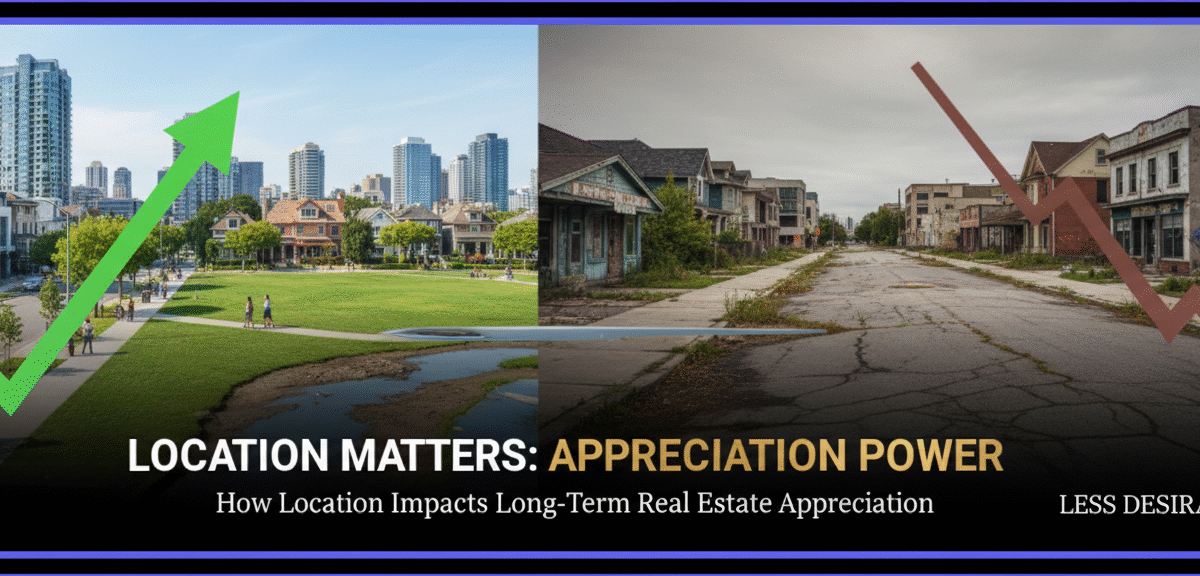When it comes to real estate investment, location remains the single most critical factor determining long-term property appreciation. While you can renovate a home, upgrade amenities, or improve interiors, you cannot change its location. This fundamental truth makes understanding how location influences property value growth essential for both homebuyers and investors. Historically, real estate in the U.S. has appreciated at an average annual rate of around 3% to 5%, but location-specific factors can significantly accelerate or slow this growth. A property in the right location can appreciate substantially faster than the national average, while one in a declining area may struggle to maintain value. Let’s explore the key location factors that drive long-term real estate appreciation.
Key Location Factors That Drive Property Appreciation:
- Neighborhood Quality and Desirability: Properties situated in desirable neighborhoods with excellent schools, low crime rates, and proximity to amenities tend to experience higher rates of appreciation. The quality of local schools is particularly influential—homes near top-performing educational institutions can sell for up to 20% more than similar properties in less desirable school districts. Safe, well-maintained neighborhoods with strong community engagement consistently outperform other areas in appreciation metrics.
- Economic Growth and Employment Opportunities: A city’s economic health forms the foundation of its real estate market. Areas with diverse industries, low unemployment rates, and recession-resistant sectors like finance, healthcare, and technology tend to attract residents seeking steady employment. Cities hosting Fortune 500 companies or major corporate headquarters experience sustained housing demand, driving consistent property appreciation. For example, tech hubs like Austin witnessed 40% year-over-year home price increases in 2021 due to high demand and economic expansion.
- Infrastructure and Connectivity: Proximity to job centers, public transportation networks, highways, and airports significantly enhances property values. Infrastructure developments such as new metro lines, highways, shopping centers, and hospitals create increased accessibility and convenience, leading to substantial appreciation. Properties within walking distance of urban amenities sell for an average of 23.5%, or approximately $77,668 more than comparable car-dependent properties, highlighting the premium buyers place on connectivity.
- Supply and Demand Dynamics: The basic economic principle of supply and demand dramatically affects real estate appreciation. When housing demand exceeds supply—often due to population growth, limited land availability, or restrictive development policies—prices naturally rise. Markets with limited housing inventory and growing populations see accelerated appreciation, while oversupplied markets experience stagnant or declining values. Understanding local market dynamics helps predict future appreciation potential.
- Population Growth and Demographics: Areas experiencing population influx and demographic shifts offer strong appreciation prospects. Growing populations increase housing demand, pushing property values upward. Cities attracting young professionals, families, or retirees see sustained appreciation as these demographics seek quality housing. Conversely, regions with declining populations or aging infrastructure may struggle with appreciation, as reduced demand limits price growth.
- Future Development Plans: Government planning, zoning changes, and upcoming infrastructure projects provide valuable insights into future appreciation. Areas slated for commercial development, educational institutions, entertainment zones, or transportation upgrades typically experience anticipatory appreciation even before projects complete. Investors who identify emerging neighborhoods before major developments can purchase properties at lower prices and benefit from significant value increases as the area transforms.
- Urban vs. Rural Dynamics: Urban and high-growth areas, particularly tech hubs like San Francisco and the Bay Area, often see appreciation rates well above the national average due to high demand and limited housing supply. These metropolitan regions attract commercial activity and skilled workers, driving sustained property value growth. In contrast, rural or economically stagnant areas may experience slower appreciation or even depreciation if population declines and economic activity diminishes, as residents relocate for better opportunities.
- Market Cycles and Timing: Real estate markets experience natural cycles of expansion and contraction. During boom periods, properties can appreciate rapidly, while downturns may slow appreciation or cause temporary value declines. However, real estate has historically demonstrated long-term resilience, consistently rebounding from market corrections. Understanding where your target market sits in the cycle helps inform buying and selling decisions, maximizing appreciation potential through strategic timing.
Location isn’t just about geography—it’s about understanding the complex interplay of economic, social, and infrastructural factors that drive property values over time. While average appreciation hovers around 3-5% nationally, location-specific advantages can push this much higher, turning good investments into exceptional ones. Before purchasing property, thoroughly research employment trends, infrastructure plans, school quality, crime statistics, and demographic shifts in your target area. Remember that appreciation compounds over time, so even small differences in annual appreciation rates can result in significantly different outcomes over a decade or more. Choose locations with strong fundamentals, growth catalysts, and sustained demand to maximize your real estate investment’s long-term appreciation potential.




